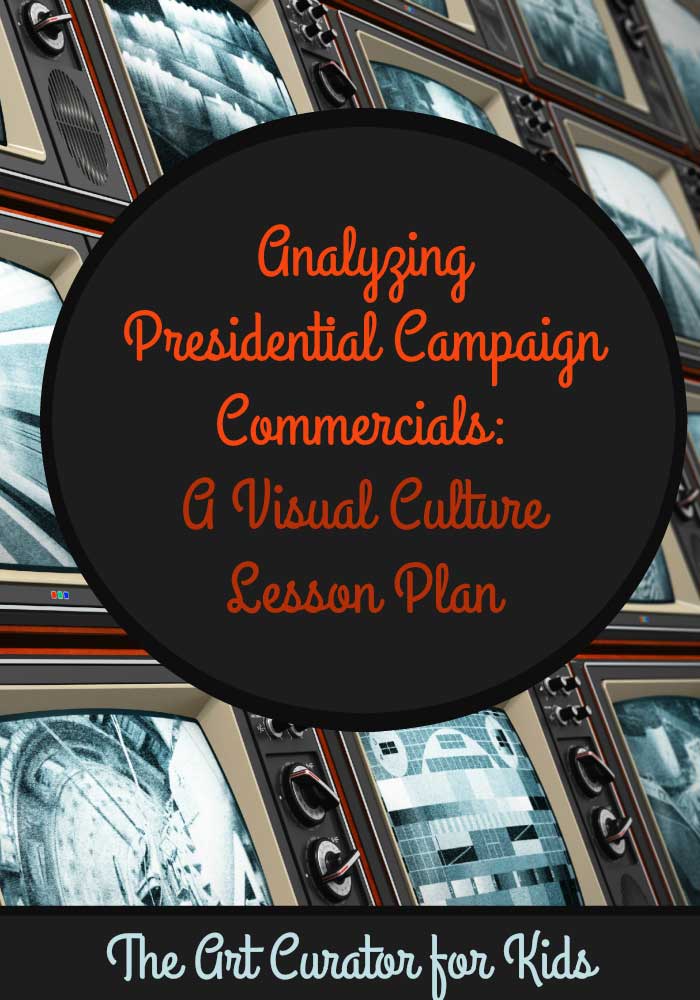When I was in grad school for Art Education, I took a class on Visual Culture. I really enjoyed the class and thinking outside of the box when it comes to defining what art is and what should be taught in an art class.
During that semester, there was an amazing exhibit at the Sixth Floor Museum in Dallas called The Living Room Candidate: Presidential Campaign Commercials 1952-2004 by The Museum of the Moving Image. I was fascinated by the exhibit and thought it was a perfect subject for my semester project. All of these campaign commercials are also online in a virtual exhibit, so this an excellent way to teach students how to decipher propaganda and how images and language can be used to manipulate emotion.
Here is the lesson I created back in grad school in 2005 (edited a bit). This is in full lesson plan format, which I don’t usually do (because I HATE WRITING LESSON PLANS! lol), but I had to do it in grad school, so it was mostly done. This was part of a larger unit about “United States Patriotism in Times of War.” Maybe I’ll put up the other lessons from the unit sometime too. Let me know in the comments if you are interested in the rest.
Grade Level: High School
Time: 9 class periods
Overview of Lesson:
Presidential campaign commercials have an impact on the public by not only inspiring votes but also inspiring patriotism, especially in times of war. Students will discover commonalities and differences in the history of campaign commercials from 1952-2012 by visiting the online exhibit, The Living Room Candidate: Presidential Campaign Commercials 1952-2012, examining and comparing war-themed commercials, and using what they learned to create a storyboard of their own campaign commercial.
Key Concepts:
- The President, being the commander and chief of the army and the leader of the country, has the responsibility of uniting the country and inspiring patriotism.
- The language, music, and imagery in campaign commercials can be analyzed to uncover manipulative techniques and ways of inspiring patriotism and evoking emotion (pathos).
Essential Questions:
- What visual, musical, and verbal messages do presidential campaign commercials project?
- How do presidential campaign commercials inspire patriotism?
Learning Objectives:
- Students will learn how to view presidential campaign commercials critically to analyze the different elements (words, music, and imagery) used to influence the audience.
- Students will learn how presidents used patriotism in their campaign commercials.
- Students will learn how political commercials have changed in the past 52 years.
- Students will learn about the elements of a storyboard and the process of creating a storyboard.
Performance Objectives:
- Students visit the online exhibition, The Living Room Candidate: Presidential Campaign Commercials 1952-2012, and reflect on the history, nature, and techniques of political campaign commercials.
- Students will use their reflections to plan and write their own political campaign commercials.
- Students will create a storyboard of their political campaign commercial
Resources:
Materials:
- Computer access for each student with internet and video streaming capabilities
- 1 16”x20” sheet of black mat board per student
- 11 sheets of 4.25” x 5.5” paper per student
- pencils, pen, and ink in various colors
Procedure:
Day One: Online Exhibition (Homework or In-Class)
Preparations:
Before giving the assignment, give the students topics to consider when viewing the online exhibition. These topics may include: differences and commonalities of the earliest and the most recent commercials, commonalities in imagery and music, aesthetic quality and artistry of commercials, evoking emotion or pathos, and ways campaign commercials depict the values of the public.
Exhibition Visit and Writing Assignment:
The students will visit the online exhibition, The Living Room Candidate: Presidential Campaign Commercials 1952-2012. Invite students to explore and experience the exhibition on their own. This can be done as homework or in the computer lab at school. Invite students to document their ideas and observation in their notebooks or sketchbooks.
Ask students to write a 1-2 page reflective response based on their museum experience. Encourage them to consider what they enjoyed most and what surprised them.
Day Two: Class Discussion
Engage students in a discussion about the exhibit experience.
Discussion motivators:
- How have the commercials changed since 1952?
- Which videos did you like best?
- What common themes emerged among the commercials?
- What recurring imagery did you notice?
- How does sound contribute to the commercials? How did the music and the voices sound?
Show Ronald Reagan’s commercial Peace from 1984 and discuss the commercial as a class.
- Describe the emotional response you felt while viewing this commercial?
- What elements of the commercial contributed to that emotional response?
- Define and discuss the term, pathos, in regards to the commercial.
- What imagery was prevalent in the commercial?
- How does the imagery inspire patriotism?
- What language does Reagan use in the commercial? Replay.
- How does the language inspire patriotism?
Show George W. Bush’s commercial Dangerous World from 2000 and discuss.
- What emotion does this inspire?
- How does Bush evoke fear?
- What is the message in this commercial?
- How does this commercial differ from Reagan’s?
- What imagery is similar to Reagan’s? What is different?
- Why would both Bush and Reagan include children in their ads?
- How does the patriotism projected in this commercial differ than the patriotism inspired in Reagan’s?
These questions hopefully will lead to the discussion of using fear and using pride to evoke patriotic feelings.
Show Lyndon B. Johnson’s commercial Peace Little Girl (Daisy) from 1964.
- Have students quietly reflect on this commercial in writing and then share their thoughts with the class.
Day Three: Exploration
Introduction to Assignment:
The students are required to create a storyboard for their own 45-second political campaign commercial. Students will use the inspiration and ideas generated from viewing various presidential commercials to write a script for a political campaign commercial and draw 9 pen and ink sketches of possible screenshots on 4.25” x 5.5” watercolor paper (8.5” x 11” paper cut into fourths). Each drawing should represent about 5 seconds of hypothetical footage. Elements such as perspective (i.e. close-ups), screen text, and music cues should be considered. Once completed, students will mount the 9 sketches with accompanying text (handwritten on strips of watercolor paper or onto the drawing itself) of any voiceovers or speaking onto a piece of 16” x 20” black mat board with rubber cement.
Explorations:
Invite students to visit the online version of The Living Room Candidate and explore the commercials located in the themed sections of “war” and “fear.” The “war” section is located by clicking “issues” on the left of the screen and then clicking “war.” The “fear” section can be found by clicking “type of commercial” and subsequently selecting “fear.” Allow students time to explore and take notes on commercial elements that may inspire ideas for their assignments.
Day Four: Concept Building
Brainstorming and Drafting:
Students must first create the script or sequence before beginning to create the images. After the writing process is complete, students must have at least one set of thumbnail images before progressing to the watercolor paper.
Days Five-Nine: Studio Production
After the brainstorming and thumbnails have been completed, allow students to experiment with the medium before beginning the official sketches. Demonstrate different techniques of applying ink such as using variations of pen nibs, adding water to colored ink to change the value, and using a paintbrush effectively for the medium. The medium is unforgiving so invite students to sketch the image onto the paper with a pencil before applying the ink.
Vocabulary:
- Patriotism: “love of country, devotion to the welfare of one’s country, the passion which inspires one to serve one’s country.” (http://dictionary.com)
- Pathos: “a style that has the power to evoke feelings” (http://dictionary.com)
- Storyboard: “A panel or series of panels of rough sketches outlining the scene sequence and major changes of action or plot in a production to be shot on film or video.” (http://dictionary.com)
Evaluation:
Students will be evaluated based on the following criteria:
- Participation: attentiveness and participation during class discussions and online exhibition visit
- Writing Activity: completion of the essay as assigned, evidence of engagement and thoughtfulness in the viewing of the commercials
- Storyboard: completion of thumbnail sketches and planning, craftsmanship in sketches and presentation, incorporation and understanding of class discussion into the final product, student commercial designed to invoke emotional response as well as has a strong and clear statement
Interdisciplinary Connections and Extensions:
Connections to Social Studies, Theatre, Language Arts, and Government are included in this lesson.






Leave a Comment